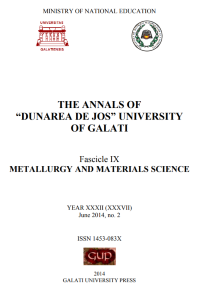Silica thin Films Obtaining by Sol – Gel Dip Coating with Controlled Optical Properties
Abstract
Transparent oxide films are widely employed as antireflection or high reflection coatings, band-pass filters and narrow-band-filters in various optical and electronic devices. The performances of these devices are based on interference effects obtained by alternating layers of high and low refractive indices. Different deposition techniques have been employed for coating glasses with different thin films materials. The metal oxides optical coatings can be deposed on glass substrate by CVD and PVD processes. The heterogeneity between the deposit and the glass substrate is the principal cause of the lack of durability of these coatings. Mono or multilayers materials could be used as colored glazing, which is slightly opaque to the human eye but highly transparent to solar energy. The glazing colors are based on interference in the thin-film coating(s) on the reverse side of the glass. Our research group focuses on investigation of single SiO2 and SiO2-TiO2 multilayers, obtained by dip-coating (DC) deposition technique using sol-gel precursors, as suitable glazing for colored solar-thermal collectors.
By optimizing the deposition parameters (number of deposition sequences, time between deposition sequences, immersion and extraction rate, temperature) and the precursor properties (concentration, additives, etc.) we are able to tailor the morphological and optical properties of silica coated glass. Consequently the transmittance has increased up to 93% in UV-VIS and IR regions and the reflectance is < 5% in VIS and IR regions.
The samples show various morphologies (mostly dense with grains around 30-40 nm) function of the precursor composition (presence of additives) and concentration.
Downloads
References
[2]. Patrice Pinel, Cynthia A. Cruickshank, Ian BeausoleilMorrison, Adam Wills - ,A review of available methods for seasonal of solar thermal energy in residential applications, Renewable and Sustainable Energy Reviews, 15, 2011, p. 3341-3359.
[3]. Christian Carboni, Roberto Montanari - Solar thermal systems: Advantages in domestic integration, Renewable Energy, 33, 2008, p. 1364-1373.
[4]. Helena Gajbert - Solar thermal energy systems for building integration, Ph.D Thesis, 2008.
[5]. Stefan Martin, Virginie Hody-Le Caer, Martin Joly, Iris Mack, Peter Oelhafen, Jean-Louis Scartezzini, Andreas Schuler - Reactively sputtered coatings on architectural glazing for coloured active solar thermal facades, Energy and Buildings, 68, 2014, p. 764-770.
[6]. Alessandro Cannale, Francesco Fiorito, Michele Manca, Giovanni Tortorici, Roberto Cingolani, Giuseppe Gigli - Multifunctional bioinspired sol – gel coatings for architectural glasses, Building and Environment, 45, 2010, p. 1233-1243.
[7]. F. Garcia, F. Yuberto, J. P. Hogado, J. P. Espinos, A. R. Gonzales Elipe, T. Girardeau - SiO2/TiO2 thin films with variable refractive index prepared by ion beam induced and plasma enhanced chemical vapor deposition, Thin Solid Films, 500, 2006, p. 19-26.
[8]. J. Boudaden, P. Oelhafen, A. Sculer, C. Roecker, J.-L. Scartezzini - Multilayered Al2O3/SiO2 and TiO2/SiO2 coatings for glazed colored solar thermal collectors, Solar Energy Materials & Solar Cells, 89, 2005, p. 209-218.
[9]. Chainhung Huang, Hsunling Bai, Yaoling Huang, Shuling Liu, Shaoi Yen, Yaohsuan Tseng - Synthesis of Neutral SiO2/TiO3 Hydrosol and Its Application as Antireflective Self-Cleaning Thin Film, International Journal of Photoenergy, 10, 2012, p. 1-8.
[10]. S. Permpoon, M. Houmard, D. Riasetto, L. Rapenne, G. Berthome, B. Baroux, J. C. Joud, M. Lauglet - Natural and persistent superhydrophilicity of SiO2/TiO2 and TiO2/SiO2 bi-layer films, Thin Solid Films, 516, 2008, p. 957-966.
[11]. Longqiang Ye, Yulu Zhang, Xianxiang Zhang, Teng Hu, Rui Ji, Bin Ding, Bo Jiang - Sol – gel preparation of SiO2/TiO2/SiO2-TiO2 broadband antireflective coating for solar cell cover glass, Solar Energy Materials&Solar Cells, 111, 2013, p. 160-164.
[12]. H. Miyazaki, T. Goto - SiOX films prepared using RF magnetron sputtering with a SiO target, Journal of Non-Crystalline Solids, 352, 2006, p. 329-333.
[13]. Y. He, L. Bi, J. Y. Frug, Q. L. Wu - Properties of Si – rich SiO2 films by RF magnetron sputtering, Journal of Crystal Growth, 280, 2005, p. 352-356.
[14]. M. Dudita, L. M. Manceriu, M. Anastasescu, M. Nicolescu, M. Gartner, A. Duta - Coloured TiO2 based glazing obtained by spray paralysis deposition for solar thermal applications, Ceramics International, 40, 2014, p. 3903-3911.
[15]. S. Kirtay, E. Oktay, V. Gunay - Glass strengthening SiO2-TiO2 organically modified silica coating, Thin Solid Films, 515, 2006, p. 2145-2152.
[16]. Hiroaki Uchiyama, Ryosuke Sasaki, Hiromitsu Kozuka - Evaporation-driven self organization of photoluminiscent organic dye-doped silica-poly (vinylprrolidone) hybrid films prepared by low-speed dip-coating, Colloid and Surfaces A: Physicochem. Eng. Aspects, 453, 2014, p. 1-6.



